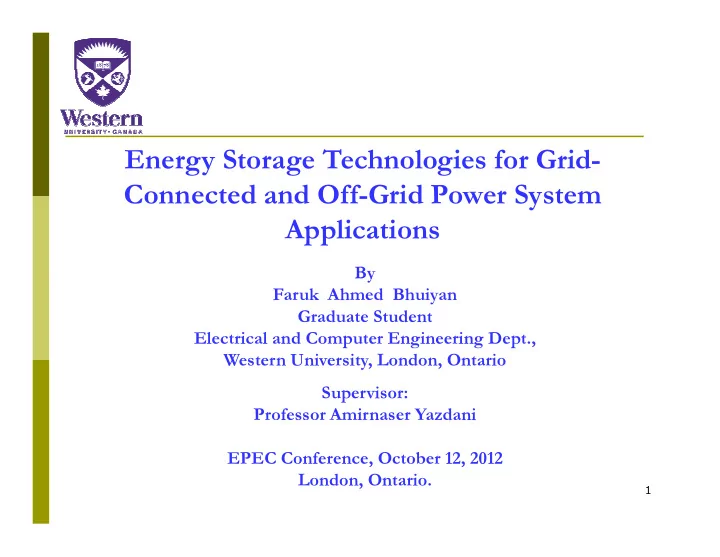

Energy Storage Technologies for Grid- Connected and Off-Grid Power System Applications By By Faruk Ahmed Bhuiyan Graduate Student Electrical and Computer Engineering Dept., Western University, London, Ontario Supervisor: Professor Amirnaser Yazdani EPEC Conference, October 12, 2012 London, Ontario. 1
Introduction • Objectives • Types of energy storage technologies • Functions/applications of ES in power systems • • Characteristics of energy storages technologies • Installed energy storages in power system applications • Few simplified models of BES • Conclusions 2
Objectives • Provide information to engineers, academia, industry people, and non-specialists • Facilitate to select the appropriate energy storage (ES) • Facilitate to select the appropriate energy storage (ES) technologies • Can be used to compare the costs of the energy storage technologies 3
Energy Storage? • Equipment that stores electrical energy in different forms for later use • Electricity demand is rarely constant over time • Renewable generation is intermittent • Renewable generation is intermittent • Excess generation during low demand period can be stored • Stored energy can be converted into electricity during high demand • Makes the electricity grid flexible, reliable and efficient 4
Types of Storage Technologies 5
Types of Energy Storages Based on Discharge Time High Power/ Rapid Discharge Energy Management (Seconds to hour) (Hours to days) Short time Medium time Long time • Capacitor • Metal air • PHES • Supercapacitor • Zebra • CAES • SMES • TES • • FES • • EVD/V-2-G Batteries • Lead acid • Nickel Cadmium • Li-Ion • NaS • Hydrogen & fuel cell Batteries • Flow • Lead acid • NaS • Li-Ion 6
Functions of Energy Storages in Power System • Frequency regulations • Spinning reserve • Voltage support • Flicker compensation • LVRT support • Peak shaving • • Source leveling • Line upgrade deferral • Energy trading • Renewable power Transmission penetration Distribution • Black start Generation • Increase Reliability End User 7
Functions of Energy Storages in Power System 8
Characteristics of Energy Storage Systems Mechanical ES Types Energy density Life cycle Respo Self Cost Cost Efficiency (Wh/kg or (cycles or nse discharge /kWh % /kW Wh/L) years) time PHES 0.3-1.5 >25 yrs min negligible 1000 15-150 70-85 CAES 10-30 >25 yrs min negligible 400-1000 10-100 40-60 FES 5-70 >20000 ms very high 600 800-2200 90 Electrical (Electromagnetic or Static) ES Types Power density Life cycle Response Self Cost /kWh Efficiency (W/kg) (cycles/yr) time discharge % Cap. >1000 >20000 ms very high >10000 75-90 SC >6000 >50000 ms very high >25000 95 SMES >10000 20 yrs ms high >20000 >95 9
Characteristics of Energy Storage Systems Electrochemical/ BES Technologies Types Energy Life cycle Response Self Cost Cost Efficiency density (cycles) time discharge /kWh % /kW (Wh/kg) PbA 20-45 200-2000 sec low >200 <300 70-80 LiI 100-200 500-4000 sec low >300 >1000 70-95 NaS 120-240 3000-9000 sec medium >400 400-800 85 NiCd 40-70 500-2000 sec low >200 400-600 60-75 NiMH 60-80 <3000 sec medium >300 600-1600 50-80 M-Air 200-2000 100-400 sec low 100-250 <400 50 NaNiCl 80-125 <3500 sec negligible 200-400 200-600 90 VRB 25 >16000 sec low >400 >500 80 H2 & 500-3000 >1000 >sec low >1200 <100 40 Fuel 10
Installed Energy Storages In Power System Application Types Specifications Location Comments Power (MW) Energy (MWh) PHES 1212 20 GWh California, USA Load labelling CAES 110 2860 Alabama, USA Peak shaving FES 20 5 New York, USA Frequency regulation PbA 10 40 Chino, CA, USA Load labelling NiCd 27 14.6 Alaska, USA Spinning reserve NaS 34 245 Rokkaso, Japan Peak shaving Li-Ion 12 5 Chile Grid stability Zebra - 40 Switzerland Spinning reserve VRB 0.25 2 Utah, USA Voltage support ZnBr 1 4 Japan Trans. deferral PSB 15 120 USA Peak shaving SMES - 2.5 MJ Korea Power quality 11
Installed Energy Storages Li-Ion BES, courtesy: A123 system NaS BES, courtesy: NGK 12 PHES, courtesy: Wiki FESS, courtesy: Beacon
BES Models Fig. 1 Fig. 2 13 Fig. 3
BES Models 14
Conclusions • Various ES technologies, especially BES systems are gaining popularity to use in grid-connected systems. • H2 and fuel cell, and flow batteries are considering for energy management in off-grid system • NaS and Li-Ion batteries are two emerging BES technologies both for grid connected and off-grid power systems • Research and development efforts on energy storage are focused on reducing cost, space, and weight; and increasing life-span. 15
Thank You 16
Recommend
More recommend